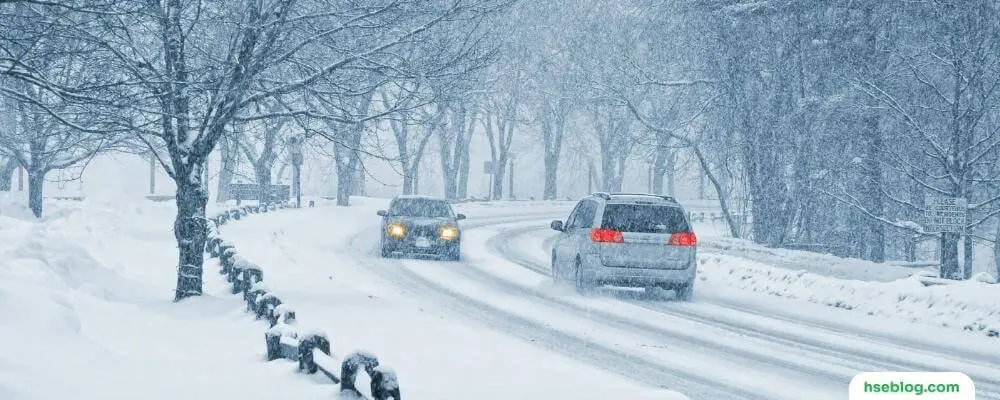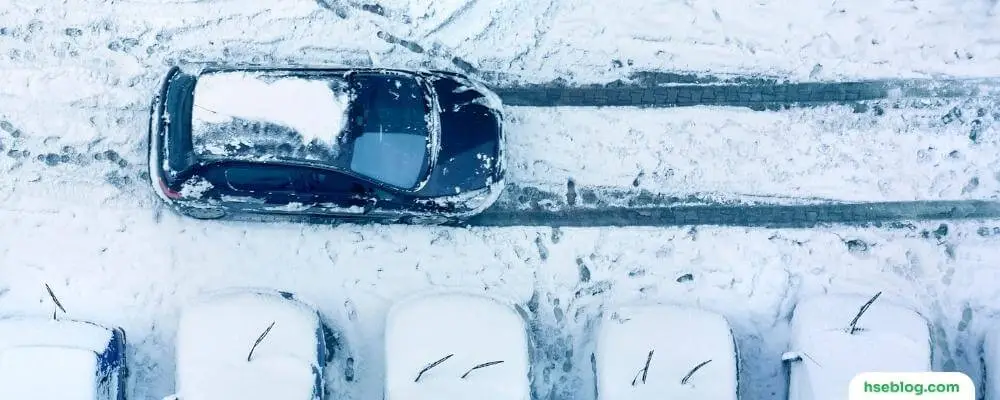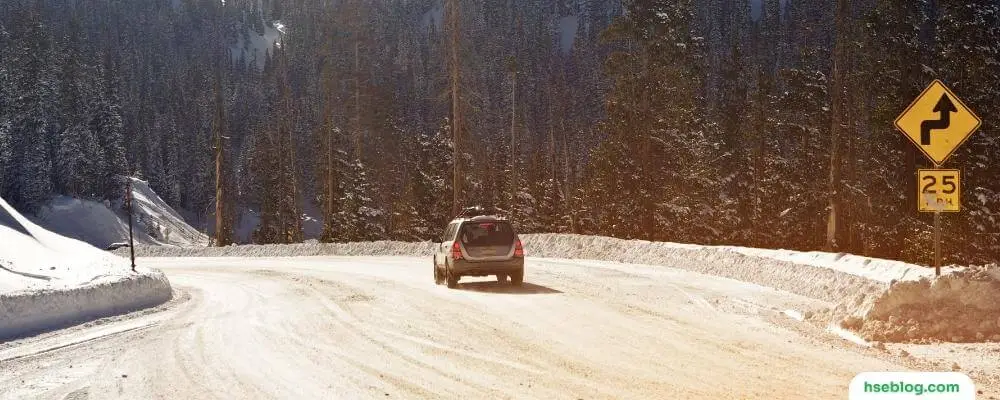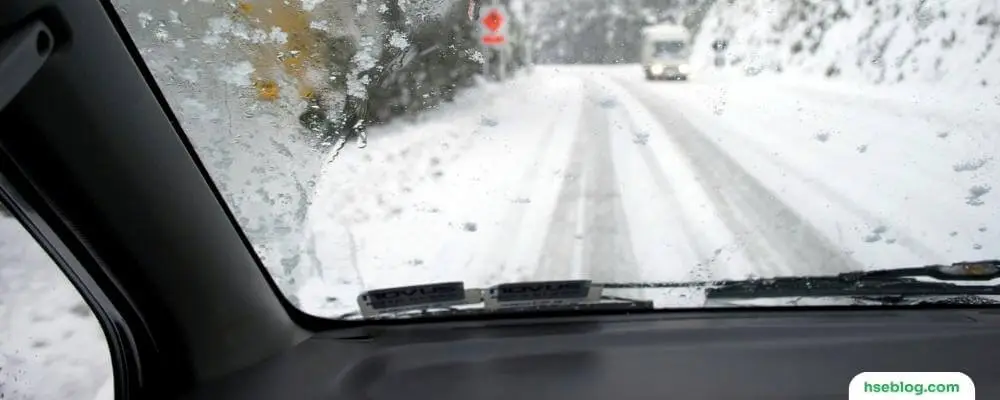Winter driving can be a challenging and nerve-wracking experience, especially when you encounter the treacherous phenomenon of black ice. This stealthy and dangerous glaze forms on roads, bridges, and overpasses when the temperature drops, making it difficult to see and easy to lose control. As a responsible driver, knowing how to handle these slippery situations is crucial, ensuring the safety of you and those around you.
Welcome to our blog, where we will delve into the world of black ice and provide you with 14 essential tips for navigating these precarious conditions. We will cover everything from recognizing black ice and adjusting your driving techniques to essential equipment and emergency protocols. By the end of this blog, you will be well-equipped with the knowledge and confidence to tackle black ice, making your winter driving experience safer and less stressful. So, buckle up and get ready to conquer one of the most hazardous aspects of winter driving!
How to Drive on Black ICE? 14 Black Ice Tips
Winter driving isn’t only about dealing with snow; ice on the road is a real threat. Black ice, in particular, is dangerous because it’s invisible (the term “black ice” being somewhat of a misnomer, as the ice is invisible). However, you can better protect yourself by understanding and be knowing how to deal with this winter issue.
Driving on black ice can be very dangerous, as the slippery road surface can cause you to lose control of your vehicle. Here are 14 tips to help you safely navigate black ice:
1. Understand That Black Ice Is Like Regular Ice
It is a glaze that forms on surfaces (especially roads, sidewalks, and driveways) because of a light freezing rain or because of melting and re-freezing of snow, water, or ice on surfaces. It’s called “black ice” because it tends to look like the rest of the pavement on the road, although in reality, it’s actually clear. Black ice forms without creating bubbles, which allows it to blend in with any surface it forms over. Black ice is dangerous precisely because it’s hard to detect in advance.

2. Know Where To Expect Black Ice
Black ice usually forms just about the freezing point. Sometimes in frigid weather conditions on highways, black ice will form due to the heat of tires on the road coupled with the freezing temperature. Keep an eye on the weather and highway reports.
- Black ice forms most commonly at night or in the early morning when the temperatures are at their lowest, or when the sun isn’t around to warm the roads.
- Black ice tends to form on parts of the road without much sunshine, such as along a tree-lined route or a tunnel. It will also form more frequently on roads that are less traveled on.
- Black ice forms readily on bridges, overpasses and the road beneath overpasses. This is because the cold air is able to cool both the top and under the bridge or overpass, bringing about faster freezing.
3. Know When To Expect Black Ice
Black ice tends to form in the early morning and evening. During the daylight hours, the road is usually warmer and less likely to create black ice. But remember: less likely does not mean “never”. Always be prepared for the possibility of encountering black ice.
- See the signs of black ice. If you are driving and see cars suddenly swerve for no apparent reason, black ice is a likely cause.
4. Know How To See Black Ice – Sometimes
While black ice is transparent, it can sometimes be seen in the right lighting conditions – if you are looking for it. Black ice almost always forms in very smooth, very glossy sheets. This glossy surface is your indication of potential black ice. If the majority of the road you’re driving on appears a dull black color, but the patch just ahead of you appears shiny, you may be about to drive onto the black ice – don’t panic, follow the instructions below.
- This technique for helping to detect black ice won’t work at night, but dawn, daylight, and dusk all offer enough light to see.
- If you are unfamiliar with this glossy appearance, think of a nice new car’s black spray paint compared to an older, un-kept car’s black paint job.
- You won’t always be able to see black ice, but looking for it can’t hurt. It may also help you to stay focused in less than ideal driving conditions. Just be sure to keep your eyes on the rest of your environment as well.
5. Practice Driving On Slippery Surfaces
If possible, (and with a seasoned winter driver) practice driving on ice in a safe surrounding. Find a nice, large, empty parking lot with ice on it. Drive on ice. Practice braking on ice. Understand how your car feels and handles in these conditions. Know what ABS braking feels like if you have it. Practicing this under controlled conditions can actually be a lot of fun!

6. Deal With A Black Ice Encounter
If you do hit black ice, your first reaction must be to remain calm and avoid overreacting. The general rule is to do as little as possible and allow the car to pass over the ice. Do not hit the brakes, and try to keep the steering wheel straight. If you feel the back end of your car sliding left or right, make a very gentle turn of the steering wheel in the same direction. If you try to struggle against it by steering in the opposite direction, you risk skidding or spinning out (see below for what to do if this happens).
7. Slow Down By De-accelerating
Lift your feet off the accelerator completely and keep your steering wheel fixed in the position it’s in. Slowing down will give you more control and prevent needless damage.
- Do not touch the brakes. Doing so will likely cause you to skid. The idea is to slide over the ice in the direction the steering wheel is facing; usually, black ice patches aren’t longer than 20 feet (6 meters).
8. If you can shift into a low gear
Low gears are useful in maintaining control of your vehicle, especially on slippery road conditions like black ice. When you shift into a low gear, you can slow down your vehicle’s speed and increase its traction. By doing so, you’ll reduce the risk of skidding, spinning out of control, or getting involved in an accident.
Driving in a low gear is also helpful when driving uphill or downhill on black ice. If you’re driving uphill, use a lower gear to help maintain traction and prevent your wheels from spinning. Conversely, when driving downhill, using a low gear can help you control your vehicle’s speed and prevent it from sliding or skidding.
It’s also important to note that using low gears on black ice can put more strain on your vehicle’s engine and transmission. As a result, it’s essential to use low gears sparingly and avoid using them for extended periods to prevent unnecessary wear and tear. Additionally, it’s essential to know your vehicle’s recommended speed range for each gear to avoid overworking your engine or transmission.
9. Head for areas of traction
Black ice is difficult to see, but it often forms in patches or sections of the road, leaving other areas with better traction. Look for areas of pavement that may offer more grip, such as textured ice or snow-covered areas. Snow and ice can create a more abrasive surface, which will provide better traction for your tires.
Another area to look for is spots with sand or gravel. Sand and gravel can provide additional grip to your tires, which can help you maintain better control of your vehicle. These materials are often used by road crews to improve traction on slippery roads, so keep an eye out for them when driving on black ice.
In addition to seeking out areas of traction, it’s important to avoid areas of black ice whenever possible. If you can, steer clear of shaded areas, as these are more likely to have black ice. Similarly, avoid driving on bridges or overpasses, as these structures tend to freeze before other areas of the road.

10. If You Skid Or Lose Traction, Stay Calm
Hopefully, you are now going slow and this will make it easier. Black ice is often (although not always) patchy, so hopefully, your tires will soon find traction. Use the minimum amount of braking possible, although some braking will be necessary if skidding a lot, as follows:
- If you have anti-lock braking system (ABS), just put your foot on the brake, apply firm pressure and the car will pump the brakes for you as you skid.
- If you don’t have ABS, pump the brakes gently as you skid.
- Always steer the car in the direction you want the car to go.
11. If you end up going off the road, try to steer into things that will cause the minimum amount of damage
Driving on black ice can be extremely dangerous, as it is difficult to see and can cause a vehicle to lose traction. If you find yourself going off the road due to black ice, it is important to remain calm and attempt to steer your vehicle towards objects or areas that will result in the least amount of damage.
If possible, aim for an open space such as an empty field or yard, where there are no obstacles to collide with. This will minimize the potential for injury and property damage. Alternatively, look for a soft, fluffy snowbank, which can help absorb the impact and slow down your vehicle more gently than a solid object.
However, it is important to remember that you may not have much control over your vehicle when sliding on black ice. In such situations, it is crucial to prioritize your safety above all else. Here are some additional tips to help you navigate black ice safely:
- Stay calm: Panicking can lead to overcorrections, which may worsen the situation. Take a deep breath and try to maintain a clear head.
- Do not slam on the brakes: Applying the brakes suddenly can cause your vehicle to skid further. Instead, gently pump the brakes if you have non-ABS brakes or apply steady, even pressure if your vehicle has ABS.
- Turn into the skid: If your vehicle begins to skid, turn the steering wheel in the direction the vehicle is sliding. This can help you regain control.
- Shift to neutral: If you’re sliding and can’t regain control, shifting to neutral can help disengage the power from your wheels, giving you a better chance to regain control.
- Keep a safe distance from other vehicles: Give yourself ample space to react if you or another driver encounters black ice.
- Slow down: Reducing your speed in icy conditions can give you more time to react and help prevent skids.
Remember, the best way to avoid black ice-related accidents is to drive cautiously and be prepared for changing road conditions. Stay alert and focused on the road, and adjust your driving style as needed.
12. After The Black Ice Encounter, Stay Calm
Encountering black ice while driving can be a scary experience, and it’s natural to feel shaken afterward. However, it’s important to stay calm and keep a level head to ensure your safety.
If you encounter black ice while driving, the first thing to do is to slow down and avoid sudden movements. Try to maintain a steady speed and avoid slamming on your brakes or jerking the steering wheel. Doing so could cause you to lose control of your vehicle, making the situation even more dangerous.
Once you’ve safely passed over the black ice, take a moment to collect yourself and assess the situation. Check for any damage to your vehicle and make sure that you and your passengers are okay. If you’re feeling shaken, take a few deep breaths and try to calm down before continuing your journey.

13. Get Off The Road As Soon As Possible
It’s better to wait a while at a rest stop, diner, or even on the side of the road until the road crews can salt and/or sand the roads than to deal with an accident. This will also allow you to recover your senses and feel less panicked. Have a hot drink and relax a while.
- If there is a pile-up: Very rarely, ice and/or black ice can make extremely hazardous conditions that can cause multi-car accidents on a highway. You will have to evaluate quickly whether staying in your car (where you have some safety protection) or getting out (where you can flee further collisions but will have to walk on icy surfaces, in freezing temperatures, with other cars spinning out of control around you) is safer. Consider your location, travel speed, geographic location, warmth, and physical abilities.
14. Prevent Or Minimize Future Encounters With Black Ice
You can do several things to reduce the chances of being surprised by black ice. While knowing how to drive on it remains a number one priority, here are some other things to do:
- Travel slowly. Don’t try to speed during icy weather as this will take away any control you might have had on the black ice.
- Don’t tailgate.
- Keep your windshield clear of ice, snow, dirt, and anything else that can prevent you from seeing out of it properly. You might be tempted to turn on your windshield wipers to get snow and ice off your car’s windshield. It might seem like the wipers and the washer fluid will work, but they don’t. In fact, if you use your windshield wipers to get ice off the windshield, you could ruin them. Use an ice scraper to scrape the ice from your car’s windshield before starting the vehicle.
- Turn your headlights on early in the afternoon to help you see any possible sheen from black ice.
- Check your tire tread. Worn tread causes accidents in any condition and will ensure you lack traction when needed on the black ice. In addition, consider having snow tires fitted.
- An important thing to remember is to NEVER drive in potentially icy conditions with your cruise control active.
Conclusion
Driving on black ice can be a daunting and potentially dangerous experience. However, with the right knowledge and following the 14 tips outlined in this blog, you can greatly increase your safety and confidence when encountering these treacherous conditions. Always be prepared, stay vigilant, and stay calm and focused. Doing so, you’ll be well-equipped to handle any challenges that black ice may throw your way.
As always, the best defense against black ice is to avoid driving in hazardous weather conditions whenever possible. By staying informed about the weather and road conditions, you can make informed decisions about whether to venture out on the roads or not. Ultimately, your safety and those of others around you should always be your top priority. Drive safe, and stay warm!

